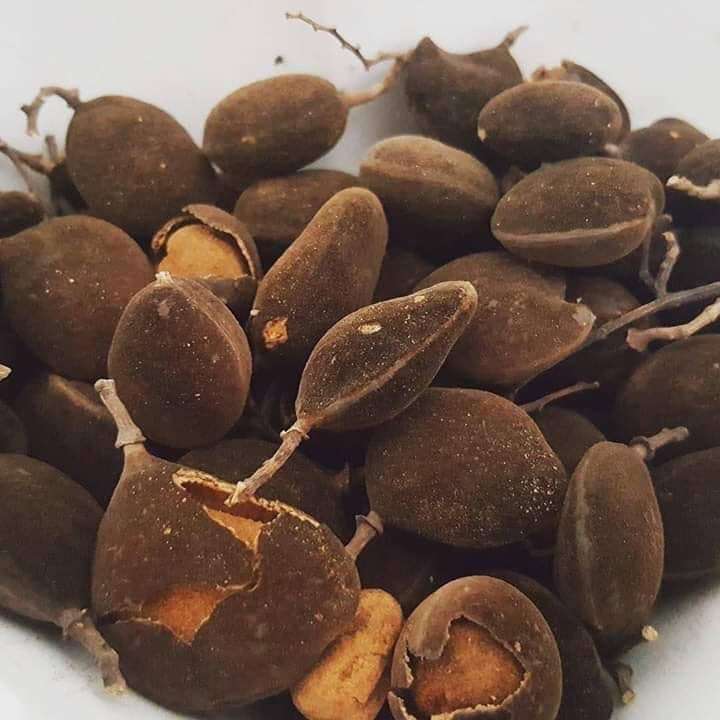Velvet tamarind (dialium guineense) commonly known as ‘icheku’in igbo, ‘awin’ in Yoruba and ‘tsamiyar- kurm’ in Hausa, and ‘Yooyi’ in Ghana, is a woody plant that occurs in the rain forest region of West Africa. It has smooth grayish bark, dark green glossy leaves, and whitish flowers which bears densely velvet black fruit that is less circular and flattened.
The pulp of the fruit is edible and sweet, rich in vitamin C, sodium, iron, magnesium and potassium. It is used as a flavor in snacks and non-alcoholic beverages.
Different parts of the velvet tamarind plant have been scientifically proven to offer a wide range of health benefits, some of them are explained below:
Treats Ulcer and Prevents Hypertension
The leave extract of velvet tamarind has the ability to increase gastric mucus secretion. Therefore, a decoction of the leave can be a remedy for gastric ulcer. The leaves are also highly diuretic – promotes the production of urine, making it easier for the heart to pump blood hence, reducing the risk of hypertension.
Malaria
According to research, the leave extract inhibits the growth of plasmodium falciparum which causes malaria therefore; taking a decoction can cure malaria.
Improves Oral hygiene and cures Toothache
The stem used as chewing stick (indigenous toothbrush) contains saponin which adds cleaning effect to the teeth and at the same time removes plaques and caries on the teeth of users. The stem bark decoction is also used to treat toothache.
Anti-inflammatory and Anti-microbial Properties
The fruit pulp contains abundant vitamin C which fights against microbial infections. The stem bark has the ability to reduce inflammation in bronchial tubes that arises due to bronchitis.

Velvet Tamarind (Yooyi)
Jaundice and Diabetes Management
A decoction of velvet tamarind leaves is used in preparing a medicinal solution for curing jaundice. It also lowers blood sugar and increases insulin sensitivity hence, can be used to treat diabetes.
Reliefs Menstrual Cramp and stops Diarrhoea
The stem bark extract has significant analgesic property hence, can be used to reduce menstrual pain. You can take it along with papaya leaf, salt, and water to work effectively. It can also stop diarrhea.
Hemorrhoids (Piles)
Piles are swollen veins in the anal canal caused by too much pressure in the pelvic and rectal areas and while not life-threatening, these veins can be very painful. A study performed on ethanolic leaves extract of velvet tamarind showed it to be beneficial for pile treatment.
Treats Scurvy and Wounds
The fruit pulp has high ascorbic acid content which is an anti-scurvy vitamin hence used as food supplement. Tender leaves of velvet tamarind, when squeezed and applied on wounds, stimulates the growth of healthy skin and protects the wounds against germs and moisture.
Improves lactation and checks genital infections
A review of several studies has concluded that chewing the fruit pulp increase secretion of milk as well as check infections.
Velvet Tamarind Increases the Antioxidant Capacity of the body
Oxidative damage which involves free radicals – highly reactive molecules with unpaired electrons, is believed to be one of the mechanisms behind aging and many diseases. The abundance of antioxidants in the leaves helps protect the human body from damage caused by these free radicals.
Source: http://thechronicle.com.gh

 News2 months ago
News2 months ago
 News3 months ago
News3 months ago
 Entertainment3 months ago
Entertainment3 months ago
 News3 months ago
News3 months ago
 Business3 months ago
Business3 months ago
 Business3 months ago
Business3 months ago
 News2 months ago
News2 months ago
 Entertainment2 months ago
Entertainment2 months ago














